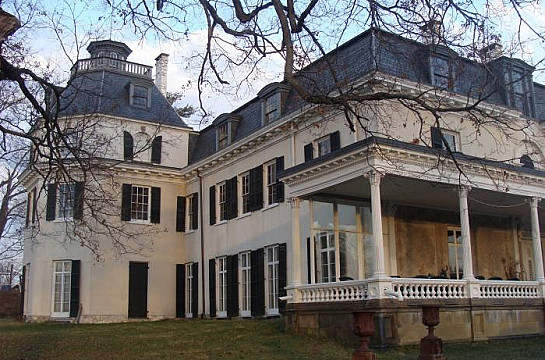Rokeby
Barrytown, Dutchess County, New York

This house is best associated with...

Sen. John Armstrong
of Red Hook, New York; U.S. Minister to France & U.S. Secretary of War
1758-1843

William Backhouse Astor, Sr.
"The Landlord of New York" & Founder of the Astor Library (1849)
1792-1875
Robert and Margaret's children - Alida and her nine surviving siblings - were all given parcels of the Livingston/Beekman land and they all built homes along the same 16-mile stretch of the Hudson River, just south of Alida's childhood home, Clermont Manor.
Escaping the Heat of the White House
Armstrong was appointed a Brigadier-General before being nominated U.S. Secretary of War by President James Madison (1751-1836). During the War, the President's wife, Dolley, took refuge at the Armstrong's home and the succeeding U.S. President James Monroe (1758-1831) also passed a night there. Armstrong was directly blamed for the British and Canadian troops burning the White House and retired from political life. Here, he settled down to focus on the construction of his new house and the landscaping of its gardens.
The Armstrongs at "La Bergerie"
There is a central entrance and interior hall which opens into three rooms on each side, and a curved staircase was located at the back of this hall. The staircase returned and entered a rectangular hall with a large skylight on the second floor. The four front bedrooms were accessed from this hall. There was originally a second straight staircase that led from grade to an elaborate door with sidelights on the second floor which was open to the main hall.
The Astors and "Rokeby"
In 1836, William Astor paid his father-in-law $50,000 for the title deed to the estate of 728 acres, renaming it "Rokeby," as a stream on the land reminded Margaret of a poem of that name written by Sir Walter Scott (1771-1832). Armstrong now spent the winters with his son, Henry Beekman Armstrong (1791-1884), and daughter-in-law, Mary Drayton Simons (1797-1882), but in the summers he always returned with the Astors to Rokeby.
Delanos, Chanlers, and the "Astor Orphans"
Around about 1850, Astor gifted 100-acres of the Rokeby estate to his daughter Laura Eugenia Astor (1824–1902) and her husband Franklin Hughes Delano (1813-1893), where they built Steen Valetje (known today as the Atalanta Estate). Franklin Delano was the great uncle of Franklin Delano Roosevelt (1882-1945), 32nd President of the United States. In 1866, Rokeby was described by Benson J. Lossing in his book The Hudson:
Rokeby is delightfully situated in an undulating park, farther from the river than the other villas, but commanding some interesting glimpses of it, with more distant landscapes and mountain scenery. Among the latter may be seen the range of the Shawangunk, in the far southwest. Here Mr Astor's family reside about eight months of the year.
Tragically, Margaret and her husband died within two years of one another leaving nine orphans who were nicknamed "the Astor Orphans". Brought up at Rokeby by a cousin and a revolving door of tutors and governesses, they were a rowdy gang who essentially lived by their own rules, but in later life were all remarkably successful in their chosen paths. The artist, Robert Winthrop Chanler, painted several murals here which can still be seen and in 1895 their family friend, Stanford White, made several architectural alterations.
Richard Aldrich, "the Angel of Puerto Rico," and Rokeby Today
Of the nine surviving Chanler children, it was Margaret Livingston Chanler (1870-1963) who in 1899 gained sole possession of Rokeby and established a dairy farm on the property. In 1906, she married Richard Aldrich (1863-1937), the music critic for The New York Times who was an accomplished piano player and, "very fond of arranging impromptu duets, trios, and other ensemble performances at Rokeby". In 1912, they commissioned Frederick Law Olmstead Jr. to make several improvements to the gardens.
Mrs Margaret Aldrich - through the influence of her great-aunt, Julia Ward Howe - joined various women's rights movements and served as a nurse in the Spanish-American War (two of her brothers were Rough Riders). She gained the sobriquet, "the Angel of Puerto Rico" and was instrumental in the foundation of the Women's Army Nursing Corps.
The Aldrichs were the parents of two children: an adventurous daughter, Margaret; and, a son to whom Rokeby was passed, Richard Chanler Aldrich (1909-1961). Richard married Susan Kean Cutler (1914-1998) - granddaughter of Hamilton Fish II - and they both died at Rokeby, which their children and grandchildren continue to call 'home' today.
You May Also Like...
Categories
Styles
Share
Connections
There is 1 member connected to this house, are you? Connect to record your link to this house. or just to show you love it! Connect to Rokeby →
David Stuyvesant Chanler's ancestor, John Winthrop Chanler, lived in Rokeby


















